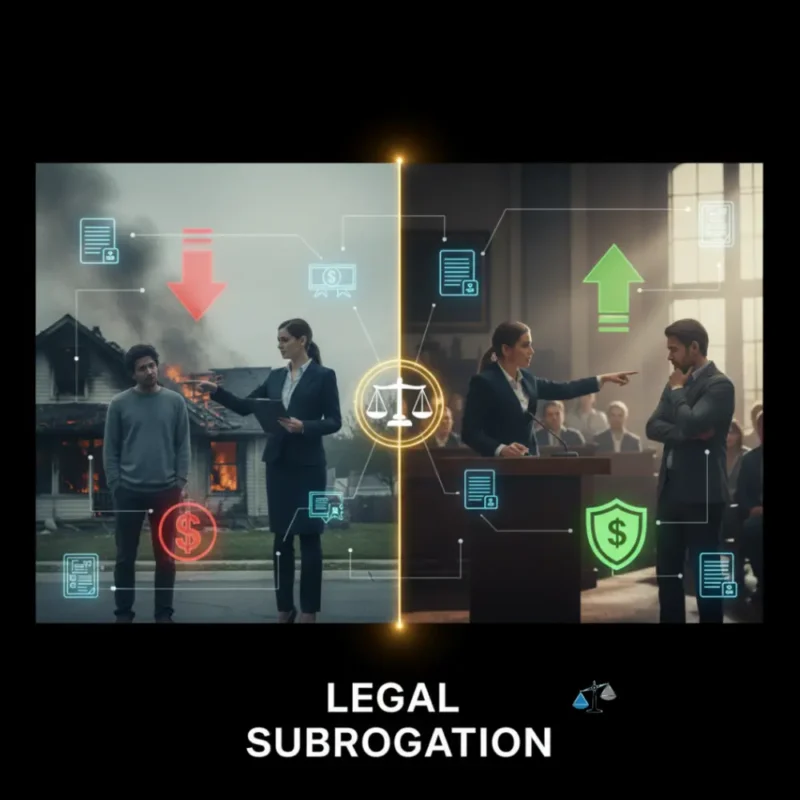Subrogation: Simple Definition and Meaning

- Subrogation: Simple Definition and Meaning
- What Is Legal Subrogation?
- Legal Basis
- Examples
- Insurance Claims
- Debt Guarantees
- Medical Expenses
- Why Legal Subrogation Matters
- FAQ About Subrogation
- How does legal subrogation work in insurance?
- Is subrogation automatic after payment?
- Can a policyholder block subrogation?
- What happens if both the insurer and insured sue the same party?
- Why is subrogation important for fairness?
What Is Legal Subrogation?
Simple definition of legal subrogation: it is the right of one party, typically an insurer, to step into the shoes of another party to recover costs from a third party responsible for a loss. In legal terms, subrogation allows the party who paid a debt or claim to assert the legal rights of the original claimant against the responsible party.
Legal Basis
The principle of subrogation comes from equity and contract law. Courts recognize it as a way to prevent unjust enrichment and ensure fairness. For example, when an insurance company compensates a policyholder for damages, the company gains the right to pursue the at-fault party.
Statutes in many jurisdictions codify subrogation rules, outlining when and how the right may be exercised. This framework ensures both the payer and the injured party are protected while avoiding duplicate recovery.
Examples
Legal subrogation is most common in insurance and debt repayment scenarios.
Insurance Claims
If an insurer pays a policyholder after a car accident, the insurer may sue the negligent driver to recover the payout.
Debt Guarantees
A guarantor who pays off another person’s debt can use subrogation to recover the amount from the debtor.
Medical Expenses
Health insurers who cover a patient’s medical bills may seek repayment from a liable third party, such as a negligent driver or employer.
Why Legal Subrogation Matters

Legal subrogation matters because it ensures fair distribution of financial responsibility. Without it, the injured party could receive double recovery, while the paying party would suffer unfair losses.
It also promotes accountability by holding the true at-fault party responsible for damages. In practice, subrogation balances the rights of insurers, guarantors, and injured parties, ensuring no side gains or loses unfairly.
FAQ About Subrogation
How does legal subrogation work in insurance?
In insurance, subrogation occurs when the insurer compensates the policyholder for a loss and then takes legal action against the responsible party. This allows the insurer to recover costs, while the policyholder avoids the burden of pursuing a lawsuit. It ensures that liability falls on the actual wrongdoer, not the insurer.
Is subrogation automatic after payment?
Subrogation rights generally arise automatically once an insurer or guarantor makes payment, but the process may depend on the terms of the contract or state law. Some jurisdictions require clear policy language, while others grant the right as a matter of equity. The specific rules can vary, making legal clarity important.
Can a policyholder block subrogation?
Most insurance contracts include clauses granting subrogation rights, meaning policyholders cannot easily block the process. However, waivers of subrogation can sometimes be agreed upon in advance, often in business or construction contracts. Such waivers must be clearly written and legally valid to prevent future claims.
What happens if both the insurer and insured sue the same party?
Courts usually prevent double recovery by ensuring only one claim proceeds. If both the insurer and insured file actions, the court may consolidate the claims or prioritize the insurer’s right to reimbursement. This system ensures the responsible party is not unfairly penalized while protecting the injured party’s interests.
Why is subrogation important for fairness?
Subrogation is important because it prevents unjust enrichment, where an insured might receive payment from both their insurer and the wrongdoer. It also ensures insurers can remain financially stable by recovering payouts from liable parties. This keeps insurance costs fairer for all policyholders while reinforcing accountability.






